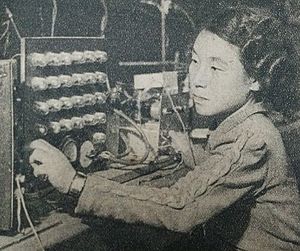Toshiko Yuasa facts for kids
Quick facts for kids
Toshiko Yuasa
|
|
|---|---|
| 湯浅年子 | |

Toshiko Yuasa in 1947
|
|
| Born | 11 December 1909 |
| Died | 2 February 1980 (aged 70) |
| Awards |
|
| Academic background | |
| Alma mater |
|
| Influences | |
| Academic work | |
| Institutions |
|
| Main interests | Nuclear physicist |
Toshiko Yuasa (湯浅年子, 11 December 1909 – 1 February 1980) was a Japanese nuclear physicist. She was the very first Japanese woman to become a physicist. She did most of her important work in France.
Contents
Early Life and Schooling
Toshiko Yuasa was born in Taitō Ward, Tokyo, in 1909. Her father was an engineer. He worked for the Japanese patent office. Her mother came from a family of writers. Toshiko was one of seven children.
She went to the Tokyo Women's Higher Normal School. This school is now called Ochanomizu University. She studied science there from 1927 to 1931. After that, she joined the Department of Physics at Tokyo Bunrika University. This university is now the University of Tsukuba. She was the first woman in Japan to study physics. She finished her studies in 1934.
Her Amazing Career
After graduating in 1934, Yuasa started teaching. She worked part-time at Tokyo Bunrika University. There, she began studying how molecules absorb light. This field is called molecular spectroscopy. In 1935, she became a lecturer at Tokyo Women's Christian College. She taught there until 1937. The next year, she became an assistant professor at Tokyo Women's Higher Normal School.
Yuasa was very interested in a new discovery. Scientists Irène and Frédéric Joliot-Curie had found out about artificial radioactivity. They made this discovery at the Radium Institute in Paris. Because it was hard to do this kind of research in Tokyo, Yuasa moved to Paris in 1940. This was even though World War II had just started in Europe.
She worked with Frédéric Joliot-Curie at the Collège de France. She studied tiny particles called alpha and beta particles. These particles come from artificial radioactive materials. She also looked at the energy of beta particles. In 1943, she earned her science doctorate degree. Her thesis was about the continuous beta-ray spectrum from artificial radioactivity.
Working During Wartime
In August 1944, Allied armies were getting close to Paris. Since Japan was allied with Germany, Yuasa was asked to leave Paris. She continued her research in a lab at the University of Berlin. There, she built her own machine to study beta rays.
In 1945, she was told by Soviet officials to go back to Japan. She traveled with her beta-ray machine on her back! When she got back to Tokyo, she became a professor again at Tokyo Women's Higher Normal School. However, she could not continue her nuclear research. This was because the United States Occupation Forces did not allow nuclear research in Japan at that time. From 1946 to 1949, she worked at the RIKEN Nishina Center. She also gave lectures at Kyoto University from 1948 to 1949.
Return to France
Yuasa went back to France in May 1949. She became a researcher for the Centre national de la recherche scientifique (CNRS). She was still a professor-on-leave at Ochanomizu University. In 1955, she decided to stay in France for good. She resigned from her job at Ochanomizu.
At the CNRS, she started studying beta decay. She used a special device called a Wilson chamber. In 1954, she wrote an article warning people about the dangers of hydrogen-bomb testing. In 1957, she was promoted to chief researcher at CNRS. Around 1960, her research changed. She started looking into nuclear reactions using special machines called synchrocyclotrons. In 1962, she received another science doctorate from Kyoto University. Her thesis was about a type of interaction in beta decay.
Later Life and Honors
Yuasa retired from the CNRS in 1974. But she kept working as an emeritus researcher from 1975. In 1976, she received a Medal with Purple Ribbon from the Japanese government. This was for her work in helping France and Japan connect through culture.
She became sick in January 1980 and was hospitalized. She passed away from cancer on February 1, 1980, at the age of 70.
After she died, in 1980, she was given the Order of the Precious Crown of the Third Class. This is a very high honor. In 2002, Ochanomizu University created the Toshiko Yuasa Prize. This prize helps young women scientists travel to France for more studies.
See also
 In Spanish: Toshiko Yuasa para niños
In Spanish: Toshiko Yuasa para niños

